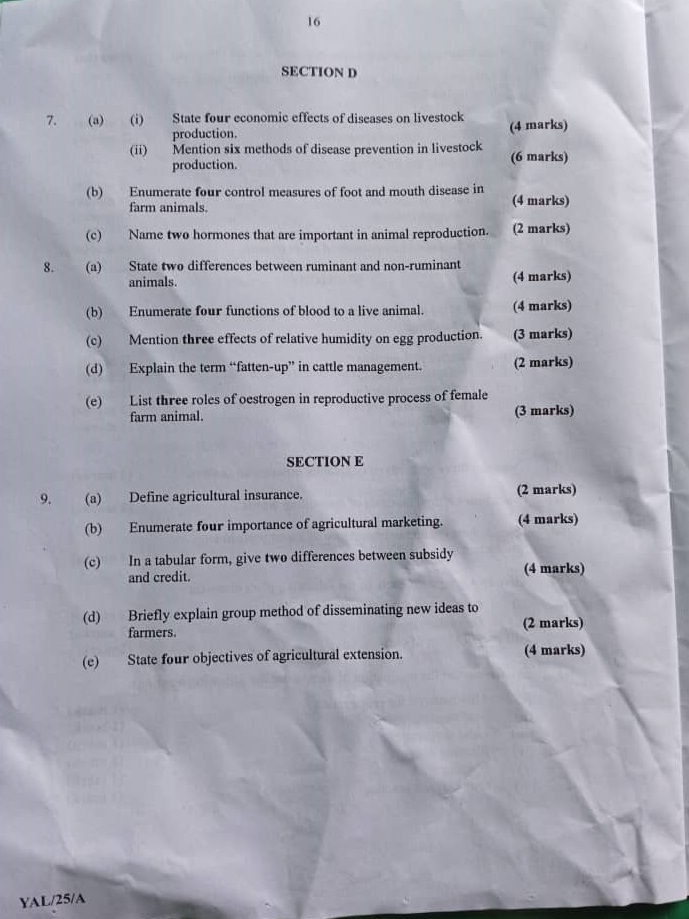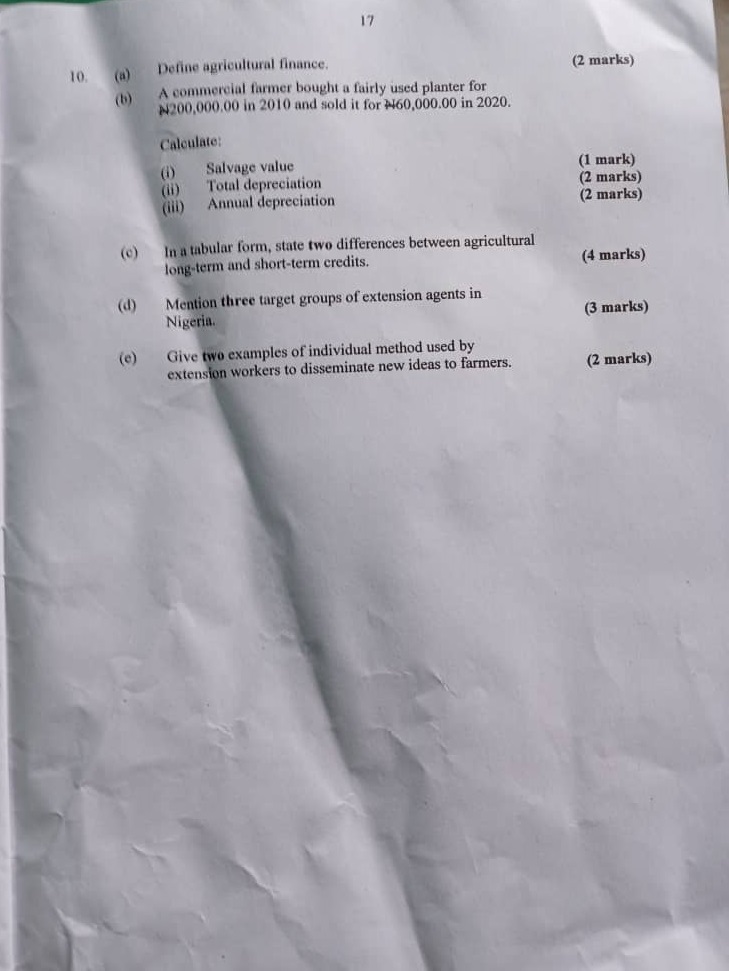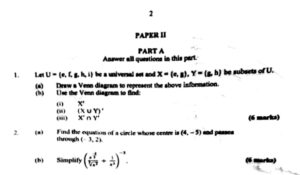2025 NECO Agricultural Science Answers
2025 NECO Agricultural Science Questions and Answers
(Essay and Objectives)
NECO Agricultural Science Answers: Get the NECO Agricultural Science Questions and answers for Paper 2 and 3 (Essay and Objectives).
We have the NECO Agricultural Science Questions and Answers Expo, so count yourself lucky to be here on our website, where we provide real and verified answers.
We are best EXAM runs website, so subscribe with us today for your NECO Examination Questions and Answers Now.
Note: Our Exam Answers come 3hours before the exam time (NECO Questions and Answers Expo and Runs ). Click here to Subscribe Now!
NECO 2025 Agricultural Science Objectives Solutions
01-10: BECDAEBDEC
11-20: EECBEEDDAC
21-30: DAADBEDCBB
31-40: BBCEAADBEA
41-50: ECECDEEAEB
51-60: CCBACAEDCB
NECO 2025 Agricultural Science Essay Solutions
NUMBER ONE
(1a)
Agriculture is the science, art, and business of cultivating crops and rearing animals for food, fiber, and other products used to sustain and improve human life.
(1bi)
=Unpredictable climate=
(PICK ANY THREE)
(i) Use of irrigation systems
(ii) Adoption of drought-resistant crop varieties
(iii) Proper weather forecasting and early warning systems
(iv) Use of greenhouses and controlled environments
(v) Timely planting and harvesting
(vi) Crop diversification to reduce risk
(1bii)
=Rural-urban migration=
(PICK ANY THREE)
(i) Provision of basic amenities in rural areas (e.g., electricity, water)
(ii) Establishment of agro-based industries in rural communities
(iii) Improvement of rural infrastructure (e.g., roads, schools, healthcare)
(iv) Access to credit and subsidies for rural farmers
(v) Training and empowerment of rural youth in agriculture
(vi) Land reforms and secure land tenure
(1c)
(i) Wear protective clothing (gloves, masks, goggles)
(ii) Do not eat, drink, or smoke while spraying
(iii) Avoid spraying during windy periods
(iv) Wash hands and equipment thoroughly after use
(1d)
(PICK ANY FOUR)
(i) Increases productivity and efficiency
(ii) Saves time and reduces labor cost
(iii) Enables timely planting and harvesting
(iv) Improves the quality of farm operations
(v) Reduces drudgery and manual labor
(vi) Enhances large-scale farming
NUMBER TWO
(2a)
(i) Communal land tenure system
(ii) Freehold land tenure system
(iii) Leasehold land tenure system
(2b)
(PICK ANY THREE)
(i) Provision of subsidies and incentives to farmers
(ii) Construction of rural infrastructure (roads, storage facilities)
(iii) Establishment of agricultural research institutes
(iv) Provision of extension services
(v) Implementation of favorable agricultural policies
(vi) Financing and granting of loans to farmers
(2c)
(i) National Agricultural Extension and Research Liaison Services (NAERLS)
(ii) Nigerian Agricultural Insurance Corporation (NAIC)
(iii) River Basin Development Authorities (RBDAs)
(2d)
(PICK ANY THREE)
(i) Provision of good road networks for easy transportation
(ii) Establishment of rural health care centers
(iii) Access to quality education and training
(iv) Provision of clean water and electricity
(v) Availability of rural credit and banking services
(vi) Building storage and processing facilities
(2e)
(PICK ANY FOUR)
(i) High cost of purchasing and maintaining machines
(ii) Displacement of manual laborers leading to unemployment
(iii) Soil compaction due to heavy machines
(iv) Inaccessibility of machines in small or rough fields
(v) Increased fuel and maintenance costs
(vi) Dependency on imported machinery and spare parts
NUMBER THREE
(3ai)
A soil profile is the vertical section of the soil that shows its different layers (horizons) from the surface to the bedrock. It reveals how the soil is structured in terms of composition, color, texture, and depth.
(3aii)
Draw the diagram
(3b)
(PICK ANY FOUR)
(i) Leaching of basic nutrients by rainfall
(ii) Excessive use of acidic fertilizers (e.g., ammonium sulphate)
(iii) Decomposition of organic matter
(iv) Continuous cultivation without liming
(v) Acid rain
(vi) Poor drainage or waterlogging
(3c)
(i) Broadcasting: Fertilizer is spread evenly over the entire surface of the soil before or after planting. It is simple but may lead to wastage and uneven distribution.
(ii) Side dressing: Fertilizer is applied beside the growing plant at some distance. It supplies nutrients during plant growth and reduces nutrient loss.
(iii) Ring method: Fertilizer is applied in circular ring around the base of the plant. It ensures efficient nutrient uptake and reduces leaching.
NUMBER FOUR
(4a)
(PICK ANY FOUR)
(i) They decompose organic matter to form humus.
(ii) They release enzymes that help break down minerals.
(iii) They aid in the weathering of rocks through chemical processes.
(iv) They fix atmospheric nitrogen into the soil (e.g., Rhizobium bacteria).
(v) They help in the recycling of nutrients.
(vi) They produce acids that dissolve rock particles.
(4bi)
=Two deficiency symptoms=
(i) Yellowing of leaves (chlorosis).
(ii) Stunted growth of plants.
(4bii)
=Two excess symptoms=
(i) Leaf tip burn or scorching.
(ii) Excessive vegetative growth with poor fruit/seed development.
(4ci)
Green manure is a type of organic fertilizer made from plants (usually legumes) that are grown and ploughed back into the soil to improve its fertility and structure.
(4cii)
Farm yard manure, this is a mixture of animal dung, urine, bedding materials, and leftover feed that is decomposed and used to enrich the soil with nutrients.
(4ciii)
Compost manure is an organic fertilizer produced by decomposing plant and animal waste materials under controlled aerobic conditions.
(4d)
(i) Biotic components.
(ii) Abiotic components
NUMBER FIVE
(5ai)
Soil requirement: Oil palm requires deep, well-drained, loamy soils rich in organic matter with a pH of 5.0–6.5.
(5aii)
Planting date: Planting is best done at the onset of the rainy season to ensure adequate moisture for root establishment.
(5aiii)
Planting: Seedlings are transplanted into prepared holes (about 60cm × 60cm × 60cm) at a spacing of 9m × 9m in a triangular or square pattern.
(5aiv)
Fertilizer requirement: Apply NPK 15:15:15 fertilizer at the rate of 0.5–1.0 kg per plant per year, split into 2-3 applications. Organic manure may also be added.
(5b)
(i) By seeds
(ii) By stem cuttings
(iii) By bulbs or tubers
(5c)
(i) Weeding
(ii) Watering/Irrigation
(iii) Mulching
(5d)
(i) Regular weeding by hand or hoeing
(ii) Crop rotation
(iii) Mulching
(iv) Proper spacing and planting density
NUMBER SIX
(6a)
(PICK ANY FOUR)
(i) They reduce crop yield.
(ii) They lower the quality of harvested produce.
(iii) They increase production costs due to pest control.
(iv) They cause physical damage to crops (e.g. boring, sucking, chewing).
(v) They act as vectors for plant diseases.
(vi) They can cause total crop failure if not controlled.
(6bi)
=Cassava mosaic=
(PICK ANY TWO)
(i) Mottling of leaves
(ii) Leaf distortion
(iii) Yellowing of leaves
(iv) Curling of leaves
(v) Stunted growth
(vi) Reduced tuber yield
(6bii)
=Groundnut rosette=
(PICK ANY TWO)
(i) Yellowing of leaves
(ii) Bushy or rosette appearance
(iii) Leaf curling
(iv) Stunted growth
(v) Poor pod development
(vi) General plant weakness
(6biii)
=Root knot of okra=
(PICK ANY TWO)
(i) Swollen or galled roots
(ii) Stunted plant growth
(iii) Yellowing of leaves
(iv) Wilting of the plant
(v) Poor fruit development
(vi) Leaf drooping
(6ci)
Setts (cut portions of yam tuber)
(6cii)
Well-drained, fertile sandy loam soil
(6ciii)
Land is cleared, ploughed, and formed into mounds or ridges
(6civ)
At the beginning of the rainy season (March–April)
(6cv)
About 1 meter × 1 meter between mounds or ridges
(6cvi)
Staking to support yam vines
NECO AGRIC SCIENCE ANSWERS
NUMBER SEVEN
(7ai)
(PICK ANY FOUR)
(i) Six economic effects of diseases on livestock production
(i) Reduction in animal productivity (e.g., less milk, meat, eggs)
(ii) Increased mortality rate leading to loss of livestock
(iii) High cost of veterinary care and treatment
(iv) Reduced market value of infected animals
(v) Cost of disease prevention and control measures
(vi) Loss of income and profitability for farmers
(7aii)
(PICK ANY SIX)
(i) Regular vaccination of animals
(ii) Proper sanitation and hygiene in animal housing
(iii) Isolation and quarantine of sick animals
(iv) Regular deworming and parasite control
(v) Adequate nutrition and clean water supply
(vi) Use of disinfectants to clean equipment and pens
(vii) Control of vectors (e.g., ticks, flies, mosquitoes)
(viii) Avoiding overcrowding in animal housing
(7b)
(PICK ANY FOUR)
(i) Immediate isolation of infected animals
(ii) Proper disposal of infected carcasses
(iii) Vaccination of healthy animals
(iv) Disinfection of animal housing and equipment
(v) Restriction of movement of animals in and out of the farm
(vi) Reporting outbreaks to veterinary authorities
(7c)
(i) Oestrogen
(ii) Progesterone
NECO AGRIC SCIENCE ANSWERS
NUMBER EIGHT
(8a)
(PICK ANY TWO)
(i) Ruminants have a four-chambered stomach while non-ruminants have a single-chambered stomach
(ii) Ruminants chew cud while non-ruminants do not chew cud
(iii) Ruminants digest cellulose efficiently while non-ruminants have limited ability to digest cellulose
(iv) Ruminants include animals like cattle, sheep, and goats while non-ruminants include pigs, poultry, and horses
(v) Ruminants have a rumen for microbial fermentation while non-ruminants do not have a rumen
(vi) Ruminants produce large amounts of methane during digestion while non-ruminants produce less methane
(8b)
(PICK ANY FOUR)
(i) Transportation of oxygen from lungs to body tissues
(ii) Transportation of nutrients to body cells
(iii) Removal of carbon dioxide and other waste products
(iv) Regulation of body temperature
(v) Defense against infections through white blood cells
(vi) Clotting of blood to prevent excessive bleeding
(8c)
(PICK ANY THREE)
(i) High humidity can reduce egg shell quality
(ii) Excessive humidity may increase disease outbreaks
(iii) Low humidity can lead to dehydration in birds
(iv) High humidity reduces feed intake in birds
(v) It can affect hatchability of eggs
(vi) It can influence egg weight and size
(8d)
Fatten-up refers to the process of feeding cattle with high-energy diets to increase their body weight and flesh in preparation for market or slaughter. It improves the meat quality and market value of the animal.
(8e)
(i) Stimulates the development of secondary sexual characteristics
(ii) Regulates the oestrous cycle and heat behavior
(iii) Prepares the uterus for implantation of the fertilized egg
NUMBER NINE
(9a)
Agricultural insurance is a type of protection provided to farmers against the loss of or damage to crops and livestock due to natural disasters, pests, diseases, or other unforeseen events.
(9b)
(PICK ANY FOUR)
(i) Helps farmers sell their produce at profitable prices
(ii) Encourages increased agricultural production
(iii) Facilitates the distribution of farm produce from rural to urban areas
(iv) Reduces post-harvest losses
(v) Provides income to farmers
(vi) Promotes investment in agriculture
(9c)
In a Tabular form
=Subsidy=
(PICK ANY TWO)
(i) Subsidy is a financial support given by the government to reduce the cost of agricultural inputs for farmers
(ii) Subsidy is usually non-refundable
(iii) Subsidy helps to encourage the use of improved farm inputs
(iv) It is often provided through government agencies or programs
(v) It reduces the production cost for farmers
(vi) It is not expected to be returned by the beneficiary
=Credit=
(PICK ANY TWO)
(i) Credit is a loan given to farmers to support agricultural activities, which may come with interest
(ii) Credit must be repaid over a specified period of time
(iii) Credit can be obtained from banks, cooperatives, or microfinance institutions
(iv) It helps farmers to invest in production, storage, and processing
(v) It may require collateral or guarantors
(vi) Interest is often charged on the amount borrowed
(9d)
The group method involves educating or training farmers in groups through methods such as workshops, demonstrations, field days, and seminars. It allows many farmers to receive the same information at once, encourages discussion, and promotes collective learning.
(9e)
(PICK ANY FOUR)
(i) To educate farmers on improved farming techniques
(ii) To increase agricultural productivity
(iii) To promote adoption of new innovations
(iv) To improve the living standards of rural farmers
(v) To link farmers with research and government programs
(vi) To provide information on marketing and farm management
NECO AGRIC SCIENCE ANSWERS
NUMBER TEN
(10a)
Agricultural finance is the provision and management of funds for agricultural production, marketing, and development. It involves sourcing, allocation, and utilization of financial resources for farming and related activities.
(10bi)
Salvage value
₦60,000.00
(10bii)
Total depreciation
= Cost price – Salvage value
= ₦200,000 – ₦60,000
= ₦140,000.00
(10biii)
Annual depreciation
= Total depreciation ÷ Number of years
= ₦140,000 ÷ 10
= ₦14,000.00 per year
(10c)
In a Tabular form
=Long-term Credit=
(PICK ANY TWO)
(i) Used for capital projects like land purchase or machinery
(ii) Repayment period exceeds 5 years
(iii) Attracts lower interest rates
(iv) Requires collateral security
(v) Helps in expanding farm operations
(vi) Usually sourced from development banks
=Short-term Credit=
(PICK ANY TWO)
(i) Used for day-to-day operations like buying seeds and fertilizers
(ii) Repayment period is usually less than one year
(iii) Attracts higher interest rates
(iv) May not always require collateral
(v) Helps in meeting seasonal financial needs
(vi) Usually sourced from commercial banks or cooperatives
(10d)
(PICK ANY THREE)
(i) Rural farmers
(ii) Youth involved in agriculture
(iii) Women in agriculture
(10e)
(PICK ANY TWO)
(i) Farm and home visits
(ii) Personal letters
(iii) Telephone calls
(iv) One-on-one
Keep Refreshing this page because More answers will be posted soon.
If you want to get the WAEC, NECO or NABTEB Questions and Answers 3Hours before the Exam Date and time, Click here. and Subscribe to our NECO Exam answers.
NECO Agricultural Science Questions




TO SUBSCRIBE FOR WAEC, NECO & NABTEB EXAM ANSWERS VIA WHATSAPP JOIN OUR GROUP
LIVE NECO QUESTIONS AND ANSWERS SUBSCRIBE NOW
We are the Top Examination Expo Website for WAEC, NECO and NABTEB Exams Runs and Verified Exam Answers provider in Nigeria, Ghana, Gambia, Sierra Leone, Liberia, Cameron, etc.
We have Questions and Answers in all Subjects for WAEC, NECO and NABTEB.
Join Our Whatsapp Group Now to gain access, Click Here To Join.
Do you know that if you are seeking admission into University, Polytechnic or College Of Education, you need to have A or B in your WAEC, NECO or NABTEB Result?
Because it gives you a better chance than those WITH C.
If you really want to have A or B in your results, make sure you subscribe to our exam runs, that is the only way to secure your admission.
Note: Our WAEC/NECO/NABTEB Exam Expo and RUNZ Answers come 3hours before the exam time (Verified Answers).
To Get Our WAEC, NECO or NABTEB Exams Questions and Answers Click Here To Get it.



